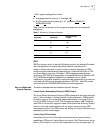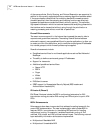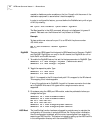
Approved DRAM SIMMs
11
Approved DRAM
SIMMs
Table 2 lists 3Com–approved vendors of the 32 MB DRAM SIMM for upgrading
the DPE 40 module.
New Features
This section describes new features in software version 11.1 for the
NETBuilder II, SuperStack II, and OfficeConnect NETBuilder bridge/routers.
VPN Features Layer Two Tunneling Protocol
Layer Two Tunnelling Protocol (L2TP) is a standards-based protocol created from
combining two similar but incompatible proprietary tunneling protocols,
Point-to-Point Tunneling Protocol (PPTP) and L2F (Cisco’s tunneling protocol). L2TP
is primarily used in Virtual Private Networking (VPN) environments and allows the
creation of a tunnel between a remote site and a central site in order to transport
Layer 3 multiprotocol traffic (such as IP, IPX, and AppleTalk) over a public IP
network.
L2TP is a connection-oriented protocol that provides flow control, packet
sequencing, and retransmission capabilities. The transport network of L2TP can be
any packet-oriented network, but for this release, UDP/IP is the supported
transport network type. Similar to a PPTP connection, L2TP puts the data inside a
PPP frame and then encapsulates the frame with a UDP/IP header.
A notable difference between L2TP and PPTP is that PPTP precedes Layer 3 frames
with a GRE header and forwards them to IP via TCP, but L2TP precedes Layer 3
frames with its own protocol header (which looks similar to a GRE header) and
forwards them to IP via UDP.
From a security standpoint, L2TP by itself, like PPTP by itself, does not provide data
encryption, authentication, or integrity functions (other than those that exist with
IP and PPP) that are critical to maintaining VPN privacy. Also, L2TP does not provide
a mechanism for key management. These areas are for further development.
IPX RAS
With this release, the NETBuilder RAS service has been extended to include IPX
RAS support. The IPX RAS functionality implemented is Proxy routing (unlike IP
RAS which can be either LAN Extension or Proxy Routing). The NETBuilder
bridge/router routes IPX traffic between the external IPX network and the internal
“Proxy” IPX network. All the IPX clients share a single Proxy IPX network and sit
logically on the Proxy IPX network. Forwarding IPX traffic to clients is based on the
Node ID (MAC address) of each client.
Table 2
3Com–approved DRAM SIMMs
Size
Vendor and Description Part Number
32 MB
72-pin 8Mx32 60 ns page mode
NEC MC428000A32B-60
Toshiba THM328020S-60
Toshiba THM328020B5-60


















